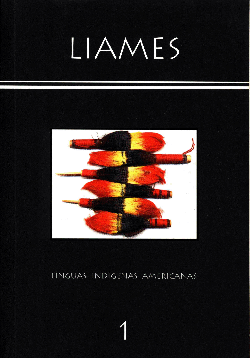Resumo
The purpose of this paper is to present the results of research on Tembé, a Tupi-Guarani language of Northeast of Brazil, with special focus on the cross-referencing system of the gerund constructions. The analysis of the data showed that the subject (Sa) of the intransitive verbs can be identical to either the subject or the object of the preceding clause, whereas the subject (A) of the transitive verbs and (So) of the descriptive verbs can only be identical to the subject of the main clause.The gerund constructions also exhibits a split system: one in which the cross-referencing of So and O is done by the relational prefixes, comprising an ergative system, and another in which the cross-referencing of
Referências
BENDOR-SAMUEL, D. (1972) Hierarchical Structures in Guajajara. Norman: Summer Institute of Linguistics, University of Oklahoma.
BOUDIN, Max H. (1966) Dicionário de Tupi Moderno. Faculdade de Filosofia, Ciências e Letras de Presidente Prudente, São Paulo.
COMRIE, Bernard. (1981) Language Universals and Linguistic Typology (Syntax and Morphology). University of Chicago Press.
DIXON, R. M. W. (1979) Ergativity, Lg. 55:59-138.
HARRISON, Carl. (1986) Verb Prominence, Verb Initialness, Ergativity and Typologica lDisharmony in Guajajara. Handbook of Amazonian Languages, VOl. 1. Edited By Derbyshire and Pullum, 407-439. Berlin: Mouton de Gruyter.
JENSEN, Cheryl. (1990) Cross-Referencing Changes in Some Tupí-Guaraní Languages. In: D.L.Payne (ed.). Amazonian Linguistics: Studies in Lowland South American Languages. Austin: University of Texas Press.
PONTES, Eunice Souza de Lima. (1986) Sujeito da Sintaxe ao Discurso. São Paulo, Editora Ática: Série Ensaios 125.
RICARDO, Carlos Alberto. (Coordenador Geral) (1985). Povos Indígenas no Brasil. São Paulo: CEDI (Centro Ecumênico de documentação e Informação).
RICE, Frederick John Duval. (1934) O Idioma Tembé (Tupi-Guarany). Journal de la Société des Américanistes, N. S., Paris (26): 109-180.
RODRIGUES, A. D. (1953) Morfologia do Verbo Tupi. Letras 1:121-152. Curitiba.
RODRIGUES, A. D. (1981). Estrutura do Tupinambá. MS.
RODRIGUES, A. D. (1984/1985). Relações Internas na Família Lingüística Tupí-Guaraní. Revista de Antropologia 27/28:33-53. São Paulo: USP.
RODRIGUES, A. D. (1986). Línguas Brasileiras: Para o Conhecimento das Línguas Indígenas. Ed. Loyola. São Paulo.
RODRIGUES, A. D. (1990). You and I = Neither You Nor I: The Personal System of Tupinambá. In: D.L.Payne (ed.). Amazonian Linguistics: Studies in Lowland South American Languages. Austin: University of Texas Press.
SEKI, Lucy. (1990) Kamaiurá (Tupí-Guaraní) as an Active-Stative Language. In:D.L.Payne (ed.). Amazonian Linguistics: Studies in Lowland South American Languages. Austin: University of Texas Press.
SHOPEN, Timothy. (1986) Language Typology and Syntatic Description. Cambridge University Press, 3 vols.
SILVA, Norval O. Da. (1993) Esboço de Gramática Pedagógica da Língua Tembé. SIL, MS.
A LIAMES: Línguas Indígenas Americanas utiliza a licença do Creative Commons (CC), preservando assim, a integridade dos artigos em ambiente de acesso aberto.
Os artigos e demais trabalhos publicados na LIAMES: Línguas Indígenas Americanas, publicação de acesso aberto, passa a seguir os princípios da licença do Creative Commons. Uma nova publicação do mesmo texto, de iniciativa de seu autor ou de terceiros, fica sujeita à expressa menção da precedência de sua publicação neste periódico, citando-se a edição e a data desta publicação.

